

Missionaries to Mormons
Introduction
In their travels throughout the Southwest, visitors soon become curious of the presence of the Spanish-style missions and churches scattered throughout the area. They seek out the history of these places, and from there learn of the role the Spanish played in changing the shape of religion in the southwest.
From the grand missions at Tumacacori and San Xavier del Bac in southern Arizona to the pueblo churches of New Mexico, the Spanish left their legacy on the land. The missionaries arrived in 1540 with Francisco Vasquez de Coronado on his expedition from Mexico City in search of gold and silver for Spain. He brought with him a convoy of mounted and foot soldiers, Indians, three women, five Franciscan monks and others. Coronado's mission was to find wealth for Spain. The monks' mission was to convert the native peoples to Christianity, God and country.
But religion did not start with the coming of the Spanish. From prehistoric times, native Indians practiced their own forms of religious ceremony involving kivas, ball courts, burial ornamentation, kachinas and other objects, as well as dances and chants. Evidence of these remain also throughout the landscape. However, once the Spanish arrived, these practices were suppressed. The Indians were confronted with the requerimiento, a document alleging that "...God the creator and lord of mankind had delegated His authority on earth to the Pope ... and the Pope in turn had donated the Americas to their Catholic Majesties, the kings of Spain" (Fontana, 1994, p. 30).
This document laid out for the Indians (whose knowledge of Spanish was as minimal as those of the missionaries for their languages) the new rules of the day. They were told that they must acknowledge Spain's sovereignty, and if they converted to Christianity they would be granted privileges, protected from their enemies, and helped in times of hardship. If they didn't, the Spanish would enter their country forcefully, inflicting punishments and deprivations on them until they agreed to obey the Church and the Spanish.
Coronado and his men left the Southwest two years later, disappointed in the lack of riches they found. There followed for the remainder of the 16th century and into the 17th many more "entradas," each one bringing more Franciscans who focused their attentions on the pueblos of Nueva Mexico. As each expedition left, the Franciscans remained behind to do their work. These monks made their presence felt, especially in New Mexico in the 16th century, establishing missions as far north as Taos pueblo, as far east as Pecos, and as far west as the Zuni and Hopi pueblos. The Spanish mission program was rooted in patronato real, a legally regulated grant of the Roman Catholic church to Spain to oversee the spread of Christianity and maintenance of the Roman Catholic church. In carrying out this mission, they forced the indigenous peoples into a more traditional Spanish one by changing their clothes, language, food, and lifestyle, and even made them tax payers.
The Spanish inflicted harsh punishments on the Puebloans. Events such as the well-known incident at Acoma Pueblo, where Governor Juan de Onate y Salazar ordered the mutilation of the feet of many Indians involved in killing his nephew are well documented. The Franciscans themselves inflicted harsh punishments on the Indians who continued their own religious practices. In 1680, the Indians rose up against the Spanish in a revolt which for 12 years kept the Spanish at bay. All the missions were destroyed and 21 out of the 33 resident Franciscans were killed.
The story in southern Arizona was a little different. The Jesuit missionaries, with Eusebio Francisco Kino probably the best known, arrived in the Primeria Alta (as northern Sonora was called) in 1687, and stayed until their removal was ordered by King Carlos III of Spain in 1767 after which the Franciscans arrived in 1768. Kino and his accompanists were welcomed openly by the natives, who helped in the construction of the missions, and were readily baptized. The Jesuits made efforts to learn the native languages, unlike their Franciscan brothers in New Mexico. They were less harsh in their punishments and maintained a more brotherly relationship with the Indians. Kino, who died in 1711, traveled extensively in Arizona, California and Sonora, and founded 24 missions among the O'Odham (Pima), introducing new religion, architecture, settlement patterns, and language.
The Franciscans remained in the southwest until the mid-19th century
when the Americans declared Arizona and New Mexico part of the U.S. territory.
New influences were placed on the land and the peoples. Among the newcomers
were the Mormons, who themselves had been persecuted in the midwestern
states. They settled into agricultural roles in northwestern Arizona especially,
and established missions with an aim to convert the natives. In the late
19th and early 20th centuries, Jewish pioneers, African American, and other
European peoples arrived, bringing with them their own various religions.
As cities grew, more churches were built, but despite this the southwest
still maintains its Indian and Spanish heritages. Our pamphlet exhibition
includes examples of some of the early missions, as well as examples of
other major churches in the region.
In order to view the following files you must have an Acrobat Reader.
If you do not possess this software, please consult the
About
the PDF link. To view a larger color image of one page of the pamphlet in JPEG, click on any image thumbnail. To view the whole pamphlet as PDF (color or black-and-white), click on the linked call number next to the thumbnail.
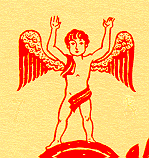 Rev. Celestine Chinn, O.F.M.
Rev. Celestine Chinn, O.F.M.
Mission San Xavier del Bac
Tucson: Daniel J. Gercke
1951, 24 pp.
R9791 S19 Pam. 1 [12.6 MB]
This ornately decorated pamphlet provides a history of the mission at San Xavier del Bac from the laying of its foundations in 1700 by the Jesuit missionary, Father Eusebio Francisco Kino, through restorations and additions by the Franciscans to its present state. The architecture, general view and specific sections are described and portrayed in the several brown-on-buff photographs found in the pamphlet.
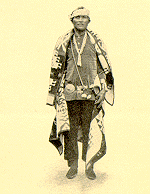 Board of the National Missions of the Presbyterian Church in the U.S.A.
Board of the National Missions of the Presbyterian Church in the U.S.A.
Ganado Mission to Navajo Indians
New York: Board of the National Missions of the Presbyterian Church in
the U.S.A.
Circa 1910s, 1 folded sheet
R9791 Pam. 68 [2.6 MB]
A series of photographs of the mission along with brief descriptions accompany the narration in this pamphlet. Written at a time when conversion of Indians to Christianity and the European lifestyle was considered critical, the reader can sense an aura of superiority as the writer expresses the perceived suffering of the indigenous peoples in one representative caption, "many...have never heard of a God of Love. They live in fear and die in terror until we bring to them the message of hope."
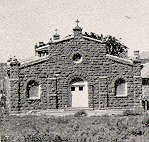 Fr. Emanuel Trockur, O.F.M.
Fr. Emanuel Trockur, O.F.M.
A Brief History of St. Isabel Mission, Lukachukai, Arizona
St. Michaels, Arizona: The Padres' Trail Press
1956, 16 pp.
R9791 Pam. 64 [1 MB]
This pamphlet, produced by the Padres' Trail Press of St. Michael's, Arizona, tells the story of the founding of Lukachukai Mission by Father Anselm in 1903 among the Navajo along the New Mexico/Arizona border. Chapel construction began in 1910, and commentary on the building of the mission house and school is included. Several black-and-white photographs accompany the narrative, and a name derivation can be found on the final page.
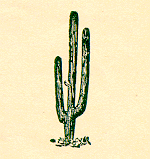 Franciscan Fathers
Franciscan Fathers
A Miracle in the Desert
Komatke, Arizona: St. John's Mission
Circa 1920s, 1 folded sheet
R9791 Pam. 34 [47 KB]
This small pamphlet, which explains the work of the boarding school on the Pima Indian Reservation at St. John's Mission, Komatke, Arizona, founded in 1897 by Franciscan Friars, is an appeal for donations. A brief history of its founding is included.
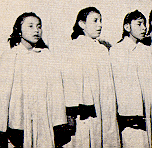 Henry J. and Pauline Reemtsma
Henry J. and Pauline Reemtsma
Navajo Presbyterian Mission
Fort Defiance, Arizona
Circa 1940s, 1 folded sheet
R9791 Pam. 9 [0.4 MB]
Another pamphlet making an appeal for support, both financial and material, has many photographs of Indian children. It includes a brief description of the mission and a sketch of the landscape.
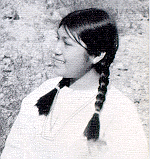 Fr. Solano
Fr. Solano
St. John's Indian School
Laveen, Arizona
Circa 1968, 33 pp.
R9791 Pam. 84 [7.6 MB]
The school yearbook for St. John's Indian School, consists of photographs of students in native dress and activities. Text describes the photographs.
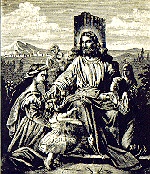 A Booklet of Catholic Prayers: Navajo--English
A Booklet of Catholic Prayers: Navajo--English
Circa 1910s, 8 pp.
R9791 Pam, 61 [1 MB]
A picture of the Lord surrounded by mothers and children sitting within scenes of the desert surrounds nine common prayer verses, written in both Navajo and English. The Lord's Prayer (Our Father...), the Hail Mary and the Apostle's Creed comprise this little pamphlet.
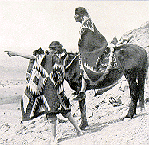 Thomas C. Moffett
Thomas C. Moffett
Facts Every Presbyterian Should Know About Indian Work
New York: The Board of Home Missions of the Presbyterian Church in
the U.S.A.
Circa 1923, 4 pp.
R9791 Pam. 69 [1.8 MB]
This item is a fact sheet written by Thomas C. Moffett for Presbyterians, asking for contributions to help in the missionary work with Indians. Focusing mainly on the Navajo and other southwest tribes, the pamphlet includes black-and-white photographs of Indian lifestyles and scenes.
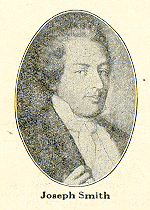 Souvenir of Your Visit to the Arizona Temple of the Church of Jesus
Christ of Latter-Day Saints,
Mesa, Arizona
Souvenir of Your Visit to the Arizona Temple of the Church of Jesus
Christ of Latter-Day Saints,
Mesa, Arizona
Joseph Smith
The Prophet Joseph Smith Tells His Own Story
Cover possibly printed Chandler, Arizona
Pamphlet printed Independence, Missouri: Zion's Printing and
Publishing Company
Circa 1920s, 24 pp.
R9791 Pam. 48 [1.8 MB]
Extracts from the history of Joseph Smith, written in 1938 on the founding and progress of the Church of Latter-Day Saints, comprise this souvenir pamphlet. The Articles of Faith are found on the inside back cover. In this case, there are very few photographs to complement the text, only one of the church in Mesa and a second of Joseph Smith and Hyrum Smith.
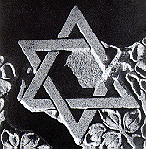 New Mexico Jewish Historical Society
New Mexico Jewish Historical Society
Foreword by Rabbi Leonard A. Helman, Introduction by Stanley M. Hordes
Stones of Remembrance, The Historic Jewish Cemetery in Las Vegas,
New Mexico
Santa Fe: Distributed by Red Crane Books
1990, 20 pp.
F804 L3 S76 [1.5 MB]
A modern pamphlet telling an historic story of the founding of the Monefiore cemetery in Las Vegas, New Mexico in 1881 by Jewish pioneers. The cemetery is described as a mute testimony of Jewish presence in New Mexico since the European colonization in the 1500's. The story is told in photographs. There is also a plan and inventory of memorials.
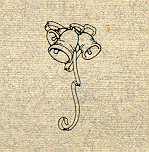 History of St. Mary's Parish, 1538-1912
History of St. Mary's Parish, 1538-1912
Phoenix, Arizona
Circa 1912, 64 pp.
R9791 Pam. 56 [2.6 MB]
St. Mary's Church in Phoenix was erected in 1881 on a site not far from a place used by Franciscan monks to convert and baptize Indians. A brief narrative of the coming of the Friars in the 1500's is followed by many photographs and description of past and present Reverends since the Church's construction. A section on the Sisters' Convent, founded in 1892, with its boarding and day schools and another on St. Joseph's Hospital conducted by the Sisters of Mercy is included. The booklet also provides current information of events, parish societies, and service schedules. The final pages (almost half of the total contents) contain local advertisements.
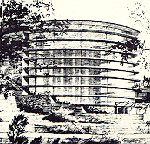 Shrine of the Ages Chapel
Shrine of the Ages Chapel
Grand Canyon, Arizona
Circa 1950s, 8 pp.
R9791 Pam. 3 [1 MB]
This colorful pamphlet is a testimony to an unfulfilled project to build a multi-faith shrine in the Grand Canyon, which had been approved by the National Park Service and Congress in 1952. Illustrations include renditions of the exterior and interior of the building, a main floor plan, and a call for donations in a section entitled, "A Part of it ... must be mine."
Introduction | Accessibility | Advertising | Agriculture | Architecture | Entertainment | Environment
Exotic | Health | Indigenous Culture | Railroads | Religion | Roads
